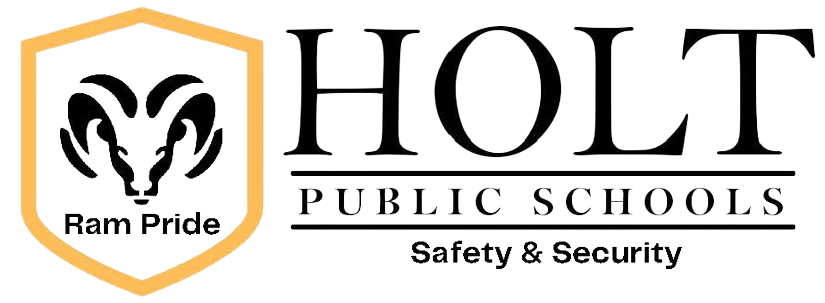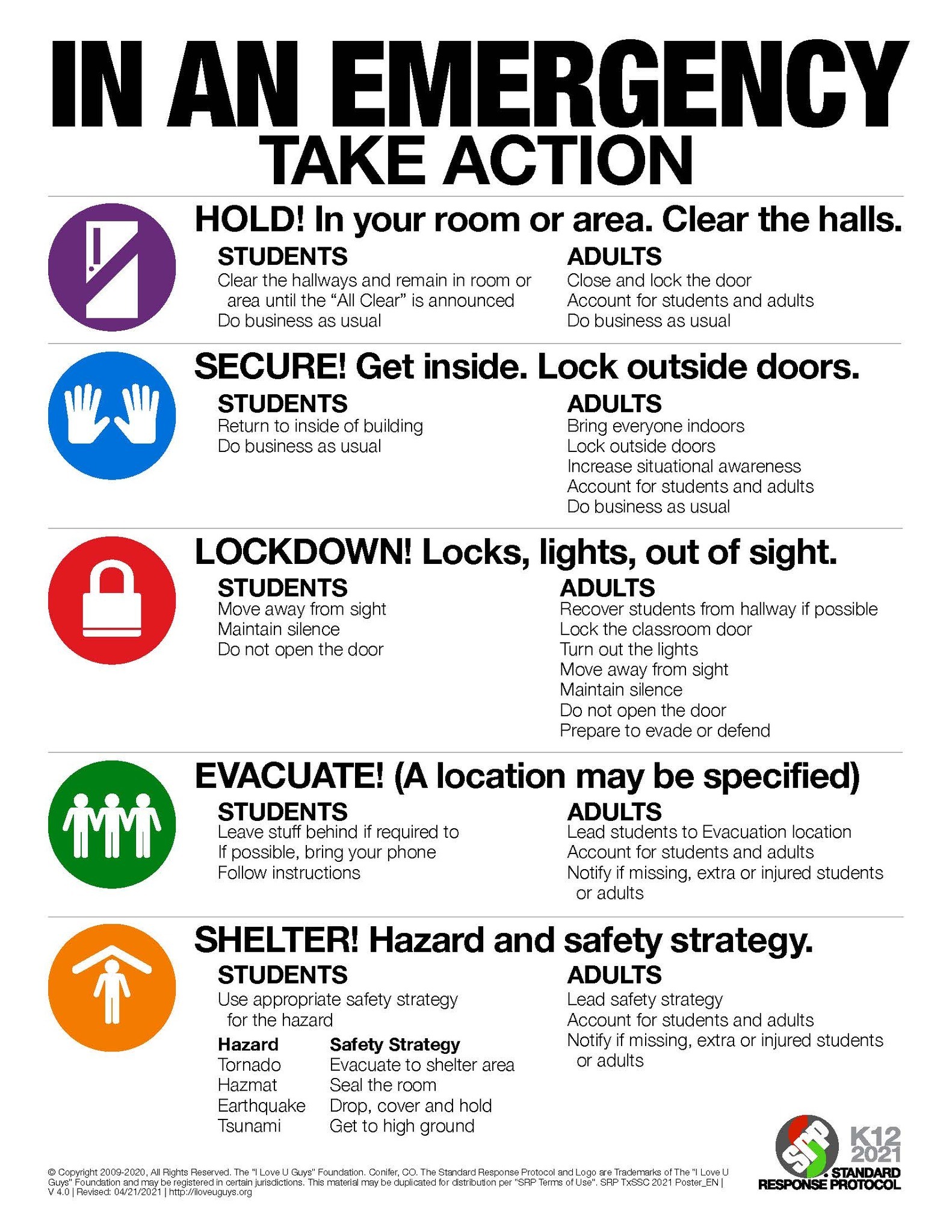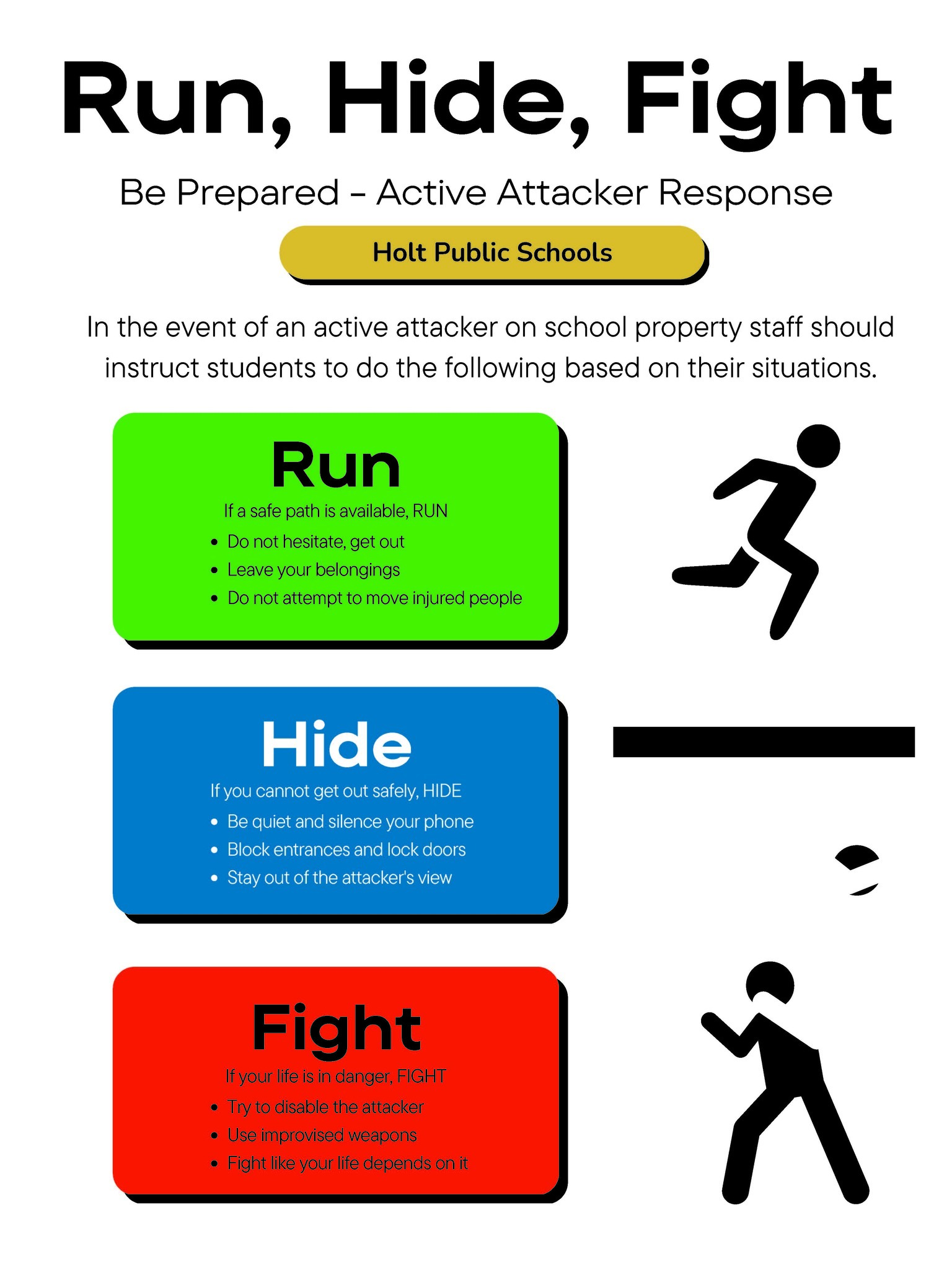
HPS is strongly committed to school safety. As part of this commitment, we are continuously assessing and improving our safety procedures and programs. As a District, we have adopted the Standard Response Protocols (SRP) as outlined by the I Love You Guys Foundation.
To support our schools in communication and response during emergency situations, the SRP provides
- Consistent language
- Colorful visuals
- Specific instructions
Each school practices these responses so that students, faculty and staff become accustomed to each of the five actions.
Secure
- Protects students and staff from a threat that is outside the school
- Involves making sure everyone is/remains inside the building.
Lockdown
- Protects students and staff from a threat inside the building
- Involves organizing students
- Inside their classrooms
- Locking the doors
- Remaining out of sight
Evacuation
- Moves students and staff out of the building to escape a threat inside, such as a fire.
Shelter
- Occurs during a
- Weather event
- Natural disaster
- Bomb
- Hazardous materials spill.
- Students and staff move to specified locations within the building and protect themselves.
Hold
- Moves staff and students out of hallways and common areas
- Maintains a safe, clear and quick passage for
- First responders
- Staff aiding someone in need of immediate care.
Why I Love You Guys?
The I Love You Guys Foundation provides easy to understand and visual standard response protocols (SRP) free to school districts across the nation. Within our District, all schools follow the same SRP, allowing us to have a common language and establish a common understanding for how we respond in emergency situations.
What additional procedures are in place?
The District Safety Team Committee addresses safety and security issues on a regular basis during monthly meetings. Safety conversations also occur internally at the building level as part of school safety committee conversation facilitated by building administrators. Conversations also occur at the district level.
Each of our buildings practices emergency drills on a regular basis. Posters, like the one on the left, are on display in all district buildings and provide a visual for students and staff as well as promote the use of common terminology across all schools.
In addition to these steps, our elementary and middle schools focus upon character education and positive school interactions through their Positive Behavior Interventions and Supports (PBIS) frameworks. Our junior high and high school implement restorative practices as a way to interact more positively with students and modify behaviors. All schools maintain an awareness of bullying and work diligently to eliminate it.
What is Run/Hide/Fight (RHF) and does the District practice this?
RHF
- An additional safety response that the District added to its SRP several years ago.
- Developed by the Department of Homeland Security
- Is an options-based approach that allows for flexibility when responding to a crisis.
- Training encourages situational awareness and encourages participants to think about how their response to a crisis might change in the moment, depending upon the circumstances.
Will my child actually be taught how to fight when this response is practiced?
No. Faculty and staff will instruct students to
- Be aware of what is happening around them
- Know that responses and/or directions for responses may change depending upon the situation
If there is an emergency, how will I be contacted?
The District will make every effort to communicate information in a timely manner via any or all of the following
- Text
- Phone
- District website
- Social media
HPS recommends that families sign up for notifications via SchoolMessenger. Directions are found on our Technology Support Website.
If I have questions about school safety procedures, to whom do I speak?
Contact your school principal about the emergency preparedness plan in response to an emergency or crisis in their respective school. Please be aware that we may not be able to share every detail of our emergency preparedness plans for security reasons; however, families are welcome to learn about our basic framework and guidelines.
What should I look for in my school’s emergency preparedness plan?
Comprehensive emergency preparedness plans include
- How students exit the building during an evacuation
- Where students would report during a shelter in place drill
- Rally points
- Reunification
- Use of school public address/automatic call systems
The District collaborates with local law enforcements and fire companies.
How can I help my school better prepare for emergencies and protect students?
Effective emergency preparedness plans are routinely revisited to identify areas in need of improvement.
- Be informed about existing plans and procedures
- Give school officials accurate contact information for your family
- Talk to your children about
- What to do
- Where to meet
- How to contact you should an emergency situation arise.
- Find ways to collaborate effectively with school staff and fellow parents and community members to best prepare for emergency situations.
OK 2 SAY
- 24 hours a day
- 7 days a week
- 365 days a year
- Call: 8-555-OK2SAY
- (855-565-2729)
- Text: 652729
- Email: OK2Say@mi.gov
- Download the App










